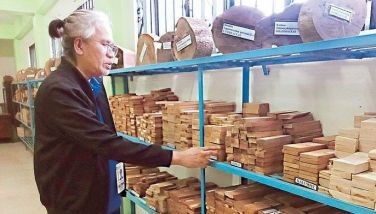Mt. Isarog, Bicol’s highest peak, now reforested
March 12, 2006 | 12:00am
PILI, Camarines Sur — Bicolanos now have reason to be happy about their region’s tallest peak, Mt. Isarog, which has been considerably reforested by concerned people and agencies.
In parts of the dormant volcano where there are no illegal settlers, its vegetation cover is now 80 to 100 percent restored.
The vegetative cover consists of premium trees and shrubs, fruit-bearing and agro-forest trees, bamboo and grass, and wild endemic and edible plants of various classifications and sizes.
Mt. Isarog is home to about 1,300 species of plants, 143 species of birds, and various species of deer, wild pigs, monkeys and wild cats.
The rehabilitation of the volcano’s slopes, the main watershed for Naga City, was reported in two separate studies done by the Camarines Sur State Agricultural College (CSSAC) in Pili town and by the Partido State University (PSU) in Sagday, Camarines Sur.
The CSSAC study was conducted by Dr. Celerino Liesol and professor Arthur Estrella while that of the PSU was done by Raul Bradecina.
The CSSAC and PSU researchers presented the results of their respective studies at a research and development (R&D) symposium of the Bicol Consortium for Agriculture and Resources Research and Development (BCARRD) held recently in Guinobatan, Albay.
BCARRD is one of the 14 government regional R&D consortia coordinated by the Los Banos, Laguna-based Philippine Council for Agriculture, Forestry and Natural Resources Research and Development (PCARRD). It is composed of R&D and academic institutions situated in the Bicol Region.
In their study, Llesol and Estrella evaluated the rehabilitation project of the Metro Naga Water District (MNWD), which is one of the major stakeholders in the utilization, protection, rehabilitation and development of the Mt. Isarog Natural Park.
They reported that the MNWD had achieved its goal of rehabilitating the denuded watershed, though it noted that regulation and control over the protected area from illegal entrants and settlers had not been fully realized.
The watershed rehabilitation project covers 317 hectares of natural secondary growth, residual forest and man-made plantation of reforested areas. About five percent of the area is open grassland and brush land and cultivated farm lots.
In his study, Bradecina noted "high community participation in conservation initiatives."
"The non-government organizations and immediate resident stakeholders of the Mt. Isarog Natural Park communities manifested the most number of initiatives in protecting the park from biodiversity loss," he said.
Bradecina reported that the 10 chief threats to Mt. Isarog are inorganic farming, slash-and-burn farming or kaingin; wildlife hunting, electric fishing, timber poaching, gathering of non-timber or minor forest plants, mono-cropping, poison fishing, burning of agricultural wastes, and treasure hunting.
PCARRD’s Dr. Leila America and Rowena Baltazar said improper waste disposal is also a problem that threatens the forests of Mt. Isarog.
In parts of the dormant volcano where there are no illegal settlers, its vegetation cover is now 80 to 100 percent restored.
The vegetative cover consists of premium trees and shrubs, fruit-bearing and agro-forest trees, bamboo and grass, and wild endemic and edible plants of various classifications and sizes.
Mt. Isarog is home to about 1,300 species of plants, 143 species of birds, and various species of deer, wild pigs, monkeys and wild cats.
The rehabilitation of the volcano’s slopes, the main watershed for Naga City, was reported in two separate studies done by the Camarines Sur State Agricultural College (CSSAC) in Pili town and by the Partido State University (PSU) in Sagday, Camarines Sur.
The CSSAC study was conducted by Dr. Celerino Liesol and professor Arthur Estrella while that of the PSU was done by Raul Bradecina.
The CSSAC and PSU researchers presented the results of their respective studies at a research and development (R&D) symposium of the Bicol Consortium for Agriculture and Resources Research and Development (BCARRD) held recently in Guinobatan, Albay.
BCARRD is one of the 14 government regional R&D consortia coordinated by the Los Banos, Laguna-based Philippine Council for Agriculture, Forestry and Natural Resources Research and Development (PCARRD). It is composed of R&D and academic institutions situated in the Bicol Region.
In their study, Llesol and Estrella evaluated the rehabilitation project of the Metro Naga Water District (MNWD), which is one of the major stakeholders in the utilization, protection, rehabilitation and development of the Mt. Isarog Natural Park.
They reported that the MNWD had achieved its goal of rehabilitating the denuded watershed, though it noted that regulation and control over the protected area from illegal entrants and settlers had not been fully realized.
The watershed rehabilitation project covers 317 hectares of natural secondary growth, residual forest and man-made plantation of reforested areas. About five percent of the area is open grassland and brush land and cultivated farm lots.
In his study, Bradecina noted "high community participation in conservation initiatives."
"The non-government organizations and immediate resident stakeholders of the Mt. Isarog Natural Park communities manifested the most number of initiatives in protecting the park from biodiversity loss," he said.
Bradecina reported that the 10 chief threats to Mt. Isarog are inorganic farming, slash-and-burn farming or kaingin; wildlife hunting, electric fishing, timber poaching, gathering of non-timber or minor forest plants, mono-cropping, poison fishing, burning of agricultural wastes, and treasure hunting.
PCARRD’s Dr. Leila America and Rowena Baltazar said improper waste disposal is also a problem that threatens the forests of Mt. Isarog.
BrandSpace Articles
<
>
- Latest
- Trending
Trending
Latest
Trending
Latest
Recommended






























